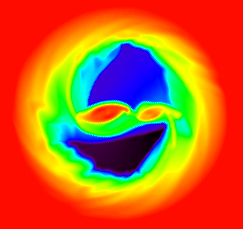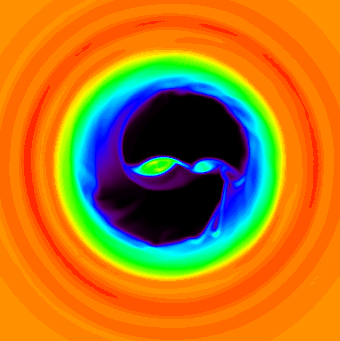Work in progress:
Accretion of gas from
circumbinary disks onto forming binary
systems
Pawel Artymowicz
Here is an example of work I am doing right now...
t = 93 P
box side = ~4.5 a
t = 156 P box
side = ~7 a


 Why is
this face in the sunglasses in the left panel smiling?
Why is
this face in the sunglasses in the left panel smiling?
Because it's a snapshot from my first PPM hydrocode simulation of a
binary system, accreting gas from a circumbinary disk, i.e. a disk around
a double star (Piecewise
Parabolic
Method
of Woodward and Collela, 1984; the code is based on John Blondin's VH-1).
The sunglasses in the middle are, in fact, the (larger) circumprimary and
the (smaller) circumsecondary `disks'. I hope that AMR (adaptive mesh refinement)
and parallel power of Hydra (cf. note at the bottom) will soon help me
resolve these regions better, which will allow to zoom in on the two point
masses orbiting each other in the simulation.
The scale is logarithmic to show the low levels
of gas density (in addition, there are density waves in the CB disk as
seen on the right, at time t=93 orbital periods). In the right-hand
panel, assuming that your monitor is set up to display the same color
as mine, the orange color is disk density~1, green color seen in the circumstellar
disks is for densities~0.01-0.1, and blueish-black colors for ~0.001 and
lower densities (down to 5E-10). This model has a temperature profile
corresponding to z/r~0.05 at the disk's inner edge. The sizes of boxes
are: 4.5a and 7a, where a = semi-major
axis of the binary system. As you see, the flow is not fully stationary,
i.e., it does vary somewhat with time, even when viewed in the corotating
frame where binary potential is stationary, because of a very small
level of numerical viscosity inherent in the PPM scheme presumably
unable to kill the initial transients (no artificial or Navier-Stokes viscosity
has been used in this run).
With Steve Lubow, we have previously studied the time dependent streamers
of gas falling from a CB disk onto a binary with the mass parameter
m2/(m1+m2)=0.3
(as
in the above picture), based on low resolution SPH models. This particular
PPM hydrocode simulation traces the streamers much better (down to much
lower densities, better resolution in the vicinity of stars). It also differs
from our previous work on eccentric binaries, in that we have here
a circular orbit binary. The phenomenon of gas flow through gaps
in accretion disks, which we discovered, is very common and robust,
and does not critically depend on the binary or disk parameters (it never
switches off completely, for instance).
The models of the kind shown here are relevant to the question of origin
of large planets (superplanets) in extrasolar systems, binaries including
brown dwarfs, and double stars, the variability of the pre-main-sequence
binaries (T Tau, UX Ori stars), and the double supermassive black holes
in the nuclei of merging galaxies.
I also have a recent technical note on the comparison
of two hydrocodes using Riemann solvers: PPM and CLAW.
These models run on a parallel cluster Hydra
which is 
This way to my
home page


